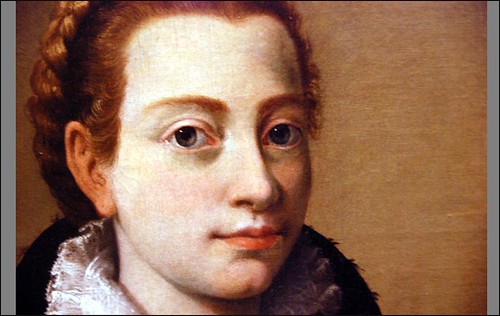Middle Ages-19th Century: Women, Gender Roles, Inequality
post 2
Renaissance
In the Middle Ages The families had a Patriarchal structure and women were expected to be wives, mothers and nuns. These roles linked back from the catholic church because of its system, but also the idelalism for morality.In the Guerrilla Girls book, Bedside Companion to the History of Western Art, they said "Almost all women worked in some family business owned by males, but the fruits of their labor was owned by their fathers, husbands or brothers"(Guerilla Girls 22). Some women worked in guilds, needleworkers and in religious communities. Women artists were forgotten in the period because of their limitations in a male dominated society. Although women played an active role, theri economic and political efforts were affected by their social class, marital status and by the times in which they lived. Everything women did was centered around their hone life, so if a woman was married she was supposed to be faithful or be buried alive and if she were raped, the mam did not face punishment. Wives were not allowed to read or because being educated was considered a conflict of what a good wife was so she had to obey her husband or be beaten.
During the Renaissance era, the systems that allowed men to paint and work were closed to women.They could not receive commissiions, or paint in academies unless they were silkmakers. Most women were illiterate at the time.In the Guerrilla Girls, Bedside Companion to the History of Western Art they touch on how there were always exceptions to the rule when it came to women being educated and able to paint in a male controlled society. "a few artists were from aristocratic backgrounds which gave them an advantage"(Guerrilla Girsl 29). An example: Sofonisba Anguiissola, a noble whose father had always supported women artists and felt they should be educated so he sent one of Sonisba's drawings to artist Michelangelo in order to have her become an established independent artist. Situations fo women were changing because laws were being in place where they could divorce husbands if they proved to be impotent, female victims of rape could save their reputations by having legal abortions sanctioned by the church,. biut only if they were aristocrats, actresses and prostitutes. So, although things seem to be changing for women, they were still unequal even among the classes of women.

Sofonisba Anguissola
The 19th Century
Equality was very important to women and their roles in art, politics and agriculture helped to improve the conditions of society, The objectification of women made the need for the Suffrage Movement even greater as women fought more than ever to be taken seriously as an equal contender in the jobs and the arts.
Wealthy and successful female artists encouraged careers in art. In order to be succesful, some women painted like men and dressed as men when they were in public to paint, sell work and of pure race because black women or muliiracial women artist were not respected and struggled to be able to paint or sell their work. In the Guerrilla Girls book, Bedside Companion to The History of Western Art they tell how women artists who did not conform to all the male societal rutles at the time in order to be successful. "There were success stories, women maanging to live as they chose, but era abound horrors too"(Guerrilla Girls 49). One example: is Rosa Bonheur (1822-1899) who was not a traditional woman artist. She is one of the most celebrated artist who lived an unconventional lifestyle as a lesbian and a femisnist. She painted animals to show the oppression of all creatures, but dressed in male clothing to be afforded the same opportunites male painters had obtained. In The Guerrilla Giirls, Bedside Companion to The History of Western Art, state that Rosa was rebellious and painted to for the love of it and to make a living. Women like her painted strong like men did. "She did it not for originality's sake, as too many women do, but simply to ficilitate my work" (Guerrilla Girls 48).
Rosa Bonheur
Women had overcome these challenges because women paintings were undecoded, but there were no more separate spheres and they now had legal rights and were becoming more liberated because of the new laws of social reformation like the Divorce Act which helped women gain legal rights to wages and take on property ownership. Women no longer needed the permission from their husbands to work and The public invisibility of women artists had diminished. There was progress by the end of the century, but there was and is work to be done in economic, and social conditions of women.
Work Cited
The Guerrilla Girls, Bedside Companion to The History of Western Art.New York:Penguin, 1998
www.google.com/images/rosa_boneur
www.google.com/images/sofonisba_anguissola

No comments:
Post a Comment